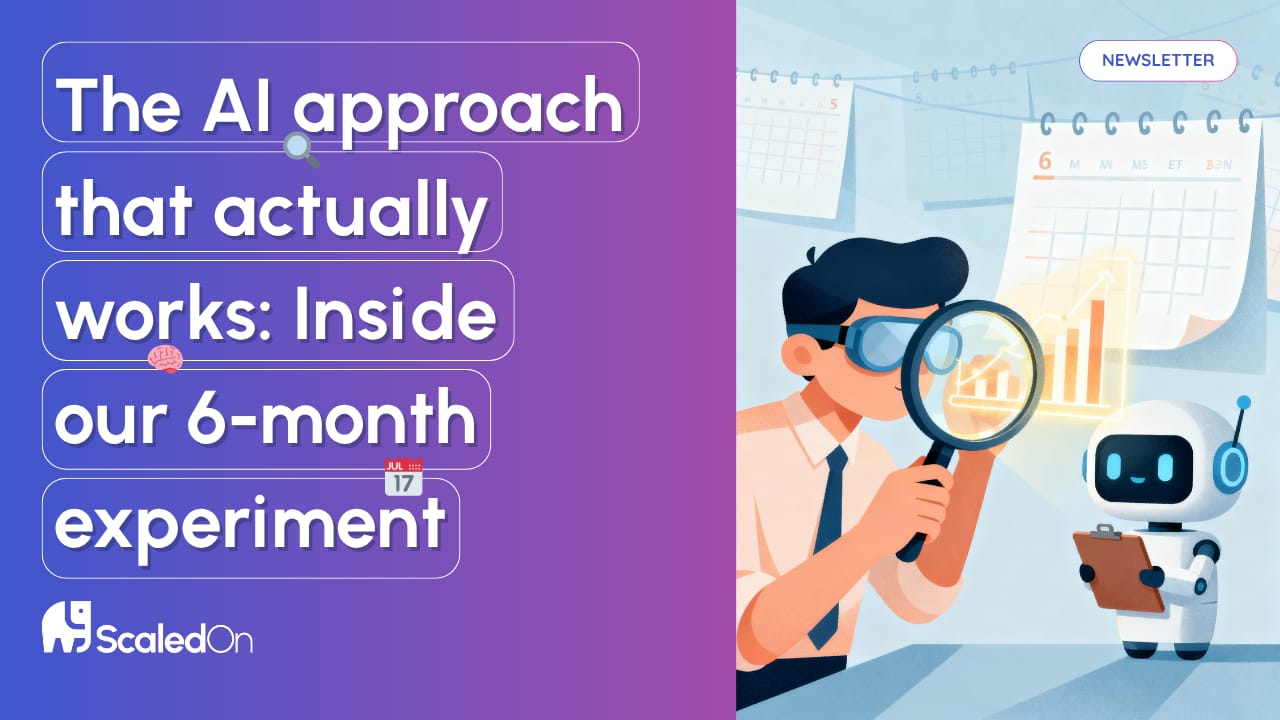Most companies are using AI wrong.
They're automating everything in sight, throwing ChatGPT at every task, and wondering why their teams aren't seeing real results.
Here's what we've learned after 6 months of actually embedding AI into our workflows at ScaledOn: AI is only as good as the co-worker using it.
We're not just playing with shiny tools. We're strategically placing AI where it eliminates busywork so our team can focus on big-picture solutions that actually drive results.
The key? Understanding the difference between automation and AI. Automation follows pre-set rules (like sending a standard follow-up email after a call). Real AI learns and adapts (like analyzing conversation tone to personalize that follow-up).
Here's how we're doing it...
Quick Insight: A Different Approach to AI
Most agencies talk about AI as if it’s a magic box that will do all the work. But let me be clear: we’re not replacing our team…we’re upgrading them.
Our approach? We're leveraging 18+ years of expertise to train AI on how we think and solve problems. Instead of letting AI dictate our process, we're teaching it to amplify our best strategic thinking.
🧠 How AI is Working at ScaledOn
Here’s where AI is helping our team:
1. Call Recording → Transcription → Task Assignment
We record every client call, transcribe it in real-time, and turn those insights into actionable tasks in minutes. No more “wait, what did they say?” moments.
Tools: Started with Fireflies.ai and Zoom.ai, and now moved to Gemini & Notion AI.
2. AI-Powered Content Creation & Email Writing
Skip the shiny marketing tools. We work directly inside ChatGPT and Claude - the same models powering those expensive platforms.
The devil is in the process. We use extensive, detailed prompts and multi-step workflows to craft email subject lines, body text, CTAs, and ad headlines. Get 60% there with AI, then it's all our team. These models handle repurposing blog posts to creating video scripts, but as part of a 4 to 5 step process that involves detailed human research and QA.
No subscriptions. No new interfaces. Just systematic prompting processes that turn foundational AI models into a powerful content creation system.
3. AI for Keyword Research & Content Optimization
We are increasingly skipping standalone SEO tools and connecting directly to data sources through MCP connectors in ChatGPT and Claude. Instead of jumping between Semrush, Ahrefs, and keyword tools, we pull SEO data straight into our AI conversations.
This lets us analyze competitors, research keywords, and identify content gaps all within the same interface where we're already strategizing. No context switching. No exporting reports. Just direct access to SEO insights that feed immediately into our content planning process.
Need SEO help? Free AI & SEO Visibility Checklist
4. AI-Powered Data Analysis & Forecasting
AI sifts through vast amounts of customer data, predicting behavior, and helping us forecast things like media mix and client revenue projections in near real-time and letting us get more repetitions and deeper insight.
Tools: ChatGPT and Claude via the API.
5. Campaign Monitoring
Our AI agents flag any anomalies from CPC spikes or CTR drops before they show up in reports. That means faster decisions and fewer wasted dollars.
Tools: Dedicated AI workflow with Zapier and ChatGPT
6. Custom GPTs for Clients
AI is trained specifically for our clients’ unique needs. From Amazon product listing optimization to targeted messaging, each custom GPT we build is tailored to drive results.
Test our Amazon Product Content Optimization GPTs
7. Trend Spotting & Market Intelligence
We feed AI massive datasets - industry reports, competitor content, social media trends, news feeds, and market research - that would take our team weeks to digest manually.
AI processes thousands of data points in minutes, identifying emerging patterns and opportunities our competitors won't spot for months. Instead of reacting to trends, our clients are positioned ahead of them.
The advantage: Human analysts can review 10-20 sources. AI can synthesize 1,000+ sources and connect dots we'd never see. That's the difference between following trends and leading them.
Tools: Manus AI, Perplixity, ChatGPT, and Claude Artifacts
📈 Quick Wins You Can Try Today
Transcribe Every Call
Use Gemini or Notion to record and transcribe client or internal calls. Turn the summaries into follow-ups and context for your AI of choice.Train AI on Your Data
Input your business data (sales, customer profiles) into ChatGPT. Train AI to personalize its recommendations and give you tailored, actionable insights for your unique audience and goals.Track Competitors’ Moves
Use a combination of Google Alerts+ChatGPT to help you track trends, new product launches, or changes in your competitors’ marketing approach.AI Project for Your Team
Assign one AI project per month to your team. Have them showcase a new AI use case each week it’s an easy way to share knowledge, explore possibilities, and get started with AI at scale.
🧭 Final Thought
I’ll leave you with this: AI isn’t here to replace the best marketers. It’s here to supercharge them. The agencies and businesses that will win are the ones that combine human talent with machine speed. That’s the playbook we’re building at ScaledOn.
Let’s scale smarter, together.
— Iulia





